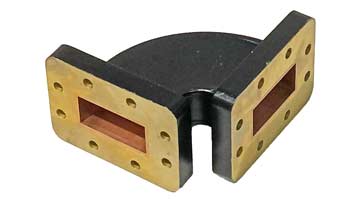Waveguide Microwave Feeder
Waveguides are RF feeders used at microwave frequencies where they are able to provide very low levels of loss.
Waveguide Tutorial Includes:
Waveguide basics
Waveguide modes
Waveguide impedance & matching
Waveguide cut-off-frequency
Waveguide flanges
Waveguide junctions
Waveguide bends
Flexible waveguide
Waveguide types & sizes
Waveguides are a form of RF feeder or transmission line used at microwave frequencies where they can offer some significant benefits over other forms of feeder, although at additional cost
A waveguide generally consists of a form of circular or rectangular conducting wall which bounds an inner space.

As the name waveguide suggests, it confines and guides the electromagnetic wave within the walls of the feeder.
As the walls are made of a conductor such as brass, and they may even be silver plated, conduction losses are low, and the electromagnetic wave cannot escape the confines of the waveguide feeder.
As a result the losses of waveguide feeders are very low when compared to other forms of feeder.
Waveguide feeder basics
Waveguides are used in a variety of applications to carry radio frequency energy from one point to another. In their broadest terms they can be described as a system of material that is designed to confine electromagnetic waves in a direction defined by its physical boundaries.
This definition gives a very broad view of their properties, but it indicates that waveguide theory can be applied in a number of areas and in a variety of different ways.
Electromagnetic waves propagating in open space travel out in all directions and can be thought of as spherical waves travelling out from a central source. As a result the power intensity decreases as the distance increases - it is proportional to the power of the source divided by the square of the distance.
The waveguide operates by confining the electromagnetic wave so that it does not spread out and losses resulting from this effect are eliminated.
Typically a waveguide is thought of as a transmission line comprising a hollow conducting tube, which may be rectangular or circular within which electromagnetic waves are propagated.
Unlike coaxial cable which is also a transmission line, there is no centre conductor within the waveguide. Signals propagate within the confines of the metallic walls that act as boundaries.
The signal propagation is confined by total internal reflection from the walls of the waveguide. As a result the conducting walls of te waveguide are important in providing the required propagation conditions.


Waveguides will only carry or propagate signals above a certain frequency, known as the cut-off frequency. Below this cut-off frequency the waveguide is not able to carry the signals.
This is obviously an important parameter, and one of the most basic specifications for its operation. It is for this reason that waveguides are typically only used at microwave frequencies.
Types of waveguide feeder
There is a number of different types of microwave waveguide that can be used, bought and designed.
Most waeguides are rectangular in cross section as this is the most common form of waveguide, but other types are available.
- Rectangular waveguide: This is the most commonly used form of waveguide and has a rectangular cross section. The dimesions of the cross section sides determine the preperties including the cut-off frequency
- Circular waveguide: This is less common than rectangular waveguide. They have many similarities in their basic approach, although signals often use a different mode of propagation. The diameter is important as this determines the operating range.
- Circuit board stripline: This form of waveguide is used on printed circuit boards as a transmission line for microwave signals. It typically consists of a line of a given thickness above an earth plane. Its thickness defines the impedance.
In addition to these basic forms, there are also flexible waveguides. These are most widely seen in the rectangular format. Flexible waveguide is often used to connect to antennas, etc that may not be fixed or may be moveable.
Waveguide feeder advantages & disadvantages
Waveguide microwave feeder has a number of significant advantages, but it also has a number of disadvantages.
Waveguide feeder advantages:
- Very low loss
- Can operate at very high frequencies (microwaves)
Waveguide feeder disadvantages:
- Expensive
- Not flexible (there are some flexible types but these are particularly expensive
- Requires special flanges and adaptors to join sections together.
Waveguide feeder is not as widely used as other forms of RF feeder like coax. However it is able to provide a very low loss method of transferring microwave power in many applications.
More Antenna & Propagation Topics:
EM waves
Radio propagation
Ionospheric propagation
Ground wave
Meteor scatter
Tropospheric propagation
Antenna basics
Cubical quad
Dipole
Discone
Ferrite rod
Log periodic antenna
Parabolic reflector antenna
Phased array antennas
Vertical antennas
Yagi
Antenna grounding
Installation guidelines
TV antennas
Coax cable
Waveguide
VSWR
Antenna baluns
MIMO
Return to Antennas & Propagation menu . . .


